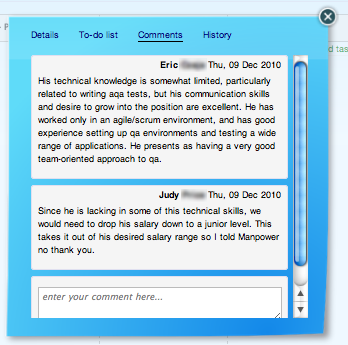This is how we used Kanban techniques to visualize our hiring workflow, empower hiring process participants, and give executives a bird's eye view on a short term project.For many companies, hiring is something that happens in spurts rather than every day, week, or even month. At this very moment, many firms may be going through a hiring process, significantly staffing up as the recession appears to ease. If you are involved in this effort and are like me, you are probably banging your head against your desk as you try to keep track of all the job candidates and what phase of the hiring process they are in, while simultaneously trying to attend to your regular job.In smaller businesses that have limited to no HR resources, this process can be a daunting endeavor. To hire for just 6 to 10 developer positions, there are often hundreds, if not more, applicants to sort through, review resumes, conduct phone and in-house interviews with, and offer jobs. Frequently, company participants have forgotten the steps and effort involved from the last time this process was enacted and therefore feel foolish as they stumble through it again. Executives and participants generally have little insight into what is going on and end up constantly emailing back and forth to check on the progress of the effort, to find out who was rejected and why, or to find out who has made it through and requires a formal offer. Interviewers must always report results back to a single point of contact (or more likely a single point of failure) who is tasked with keeping track of every candidate's application "state." Finally, anyone other than the single point of contact is usually clueless when a potential candidate calls in to check on the status of their application. After going through a full on hiring process, most people, other than seasoned HR professionals, are loathe to attempt it again.To combat the organizational nightmare that is inherent in intensive short term one-off projects, a group at our company took a stab at visualizing our hiring process workflow on a Kanban board. Our CTO made the suggestion, as our company is currently in the process of making a heavy transition to Kanban (facilitated by Jim Benson's amazing consultancy) and we all have "Kanban on the brain." My first reaction to this suggestion was, "haha, thats a good one" but after a moment of contemplation, I realized this was truly a great idea. Our team used Kanban Tool (kanbantool.com), as we have multiple remote users, but this could just as easily be done on a traditional white board, with Agile Zen, or even Google Draw.I worked with our office manager Judy, the CTO Jabe, and the developers responsible for interviewing candidates to come up with a Kanban board reflecting our ideal hiring workflow, accompanied by a document laying out roles and responsibilities associated with each column on the board. We held a 30 minute kickoff meeting to describe the process to all involved and get feedback and then we were off the races. Our company has a good amount of experience with "Agile" after working within Scrum parameters for the last 3 years so everyone understood that the Kanban board and hiring process might start off imperfectly but the goal would be to adapt and improve along the way.This is the document which was shared with all hiring process participants, containing roles and responsibilities:Interview Process DocumentHere is a screen grab of our Kanban board (click to see full size):





